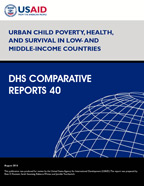
Abstract:
This report examines levels and trends in
poverty, health status, and use of health
services among children under age 5 living in
large cities in low- and middle-income
countries, and compares their health status
and
use of services to those of their other
urban, rural, and non-poor counterparts.
Twenty-six countries were selected for
inclusion; these are the countries with one
or more large cities of more than one million
inhabitants in 2014 and that had at least two
DHS surveys, one between 1998 and 2004 and a
second in or after 2010. Poverty was assessed
using the method of unsatisfied basic needs
(UBN) to provide comparable
levels in three categories (extremely poor,
moderately poor, and not poor). Differentials
in levels and decadal trends in 17 health
indicators were examined, and the results are
shown for individual countries, as
well as for the pooled weighted cross-country
averages. On average, across the 26 low- and
middle-income countries studied, we estimate
that three out of four children under age 5
live in extreme poverty. Poverty is highest
in rural areas. About half of children under
age 5 who live in large cities are extremely
poor, over half in other urban areas, and
more than 4 of 5 in rural areas. While
extreme poverty has decreased overall and in
rural areas, extreme poverty has increased in
large cities.
The chances of survival of children under age
5 are greatest in urban areas compared to
rural areas. Poor children in large cities
and other urban areas have similar chances of
survival to age 5. Nutritional status of poor
children in large cities is better than in
other urban areas, which in turn is better
than in rural areas. Both infant and under-
five mortality have decreased substantially,
with the greatest decadal decline
observed among the extremely poor. Small
improvements were made in children’s
nutritional status, notably for stunting and
anemia. Nutritional status has improved more
among the poor than non-poor
children in all areas, including the large
cities. The survival gap between the poor and
non-poor has narrowed considerably.
Similarly, the disadvantage of poor children
in stunting and anemia has been
reduced. Among the 12 indicators of health
service use in this report, nine show
moderate or large differences between the
poor and the not poor. The gap between the
poor and not poor has narrowed for eight of
these
indicators. In large cities, the gap
decreased for 10 of the 12 indicators,
although the narrowing was small for three
indicators.
Overall, there appear to be numerous health
advantages to living in an urban area, but
these advantages are not conferred to all
children. In survival, we see stark
disparities across levels of poverty. For all
indicators, the urban extremely poor children
fare better than their rural extremely poor
counterparts, but not as well as non-poor
rural children. Despite the narrowing of gaps
in many health outcomes between poor and
nonpoor and between urban and rural areas,
the persistence of poverty and increases in
extreme poverty in large cities in low- and
middle-income countries remain cause for
concern.
